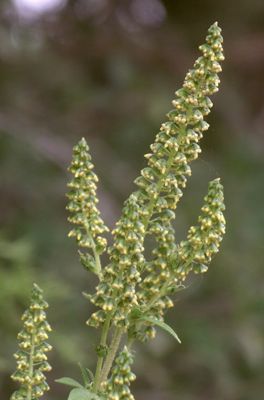
the flowers of Giant Ragweed
I am not affected by pollen allergies and so can observe the various phenomena related to plant sexual reproduction with relative detachment. But from the number of medical clinics that specialize in allergies, as well as the number of my friends that show obvious symptoms, it is clear that this problem is not a small one here in central Texas. The oaks in the spring, the grasses in summer, the ragweed in fall, and the junipers in winter are some major players contributing to the invisible pollutants drifting about in our air. During and after wet times, the fungi join in, releasing liberal amounts of spores. I can tell when there are more particles than usual in the air as it makes me sneeze a bit. It is also hard to miss seeing the clouds of dust released when a branch or stand of grass is disturbed.
 the flowers of Giant Ragweed |
While most animals are mobile, and can therefore contact one another directly, plants are much less so. Some plants self-fertilize, but this is not particularly desirable as the genes don't get much shuffling done that way. Even though many flowers have both male and female parts, they usually mature at different rates and so assure that cross-pollination will prevail. A great number of plants produce elaborate flowers for the sole purpose of luring animals (usually insects, but sometimes birds, bats, or other small creatures) to them so they can pick up and deliver pollen to other plants. Pollen from these flowers is on the large side and never independently airborne, so it is not an issue for allergy sufferers. One common misconception is that the beautiful autumn Goldenrod flowers contribute to the agony of sensitive individuals, but it is simply an unfortunate coincidence that it blooms at the same time as Ragweed, which is the real culprit. One way to recognize a wind-pollinated plant is that the flowers are almost always tiny and inconspicuous. The wind does not need any incentive to move pollen.
In an urban environment like Austin, the trees seem to be the most problematic producers of pollen. However, in more rural agricultural areas, the grasses play a bigger role. The allergy affliction is, after all, called "Hay Fever." The Great Plains, with their diverse native grasses, as well as cultivated crops of wheat, oats, rye and corn, are at times awash in pollen. I like to think of it as the wind-swept spray above the amber waves of grain.
The next time you are cleaning off the coating of pollen from your automobile's windshield or wiping your nose and eyes, it might be little comfort to think of the reason, but without pollen, life on Earth would be profoundly different. Plants produce the oxygen we need while processing the carbon dioxide we expel. Our entire food web is based on plants converting energy from the Sun into usable elements that nourish animals, including ourselves. Diversity creates a healthy and flexible ecosystem, so the more that plants of all kinds manage to mingle their genetic material, even at the discomfort of our mucus membranes, the better it is for the entire biosphere.